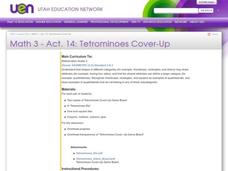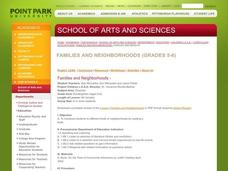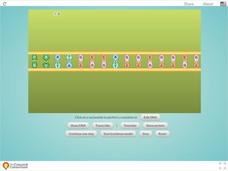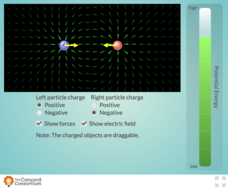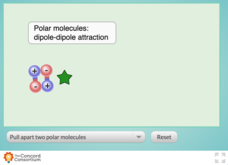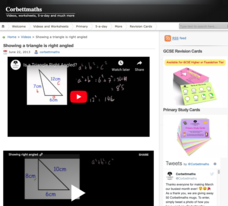Curated OER
Radish Seed Lab
In this radish seed activity, students fill out a lab packet having to do with radish seeds. Students answer short answer questions, charts, and draw graphs of their results.
Curated OER
Shoes: Practical vs. Fashionable
Students compare and contrast the difference between practical applications of apparel and the use of fashion as a status symbol, with a focus on shoes. Working in groups, they complete a Venn diagram comparing practical fashion to...
Curated OER
Tetrominoes Cover-Up
Third graders compare and contrast the attributes of two-dimensional shapes. Using a tetrominoes game, they create two-dimensional shapes to cover up a game board. At the conclusion of the game, 3rd graders discuss the patterns they...
Curated OER
Looking at Portraits: Reading Poe
Students study the poetry of Poe. In this integrated arts lesson, students draw comparisons between the daguerreotype of Edgar Allan Poe by an unknown photographer with Poe's poetry.
Curated OER
Families and Neighborhoods
Students answer questions about families and what they do together. Students discuss different types of families and draw a picture of their family, discussing similarities and differences in the pictures and in families in general.
Curated OER
Gears 2
In this gears worksheet, students use a ruler and gears to conduct an experiment. Students follow 11 sets of directions,write a conclusion, and graph their results.
Curated OER
Wind speed at different locations
In this wind speed worksheet, students walk around the school with a weather vane or wind sock and record the speed of wind in different places. Students fill in a chart and write one conclusion.
Curated OER
Logic
In this geometry activity, 10th graders use Venn diagrams to describe conditional statements and use the Law of Detachment or the Law of Syllogism to find a valid conclusion to an argument. The two page activity contains fourteen...
Curated OER
Symmetrical Journals
Learners identify symmetrical shapes around their classroom and make symmetry journals. In this symmetry lesson plan, students make drawings of symmetrical shapes inside their journals.
Curated OER
Secondary Robot
Students identify the forces acting on a stationary/constant velocity robot. In this physics lesson plan, students draw a free body diagrams of the forces. They explain the difference between zero acceleration and zero net force.
Concord Consortium
Opposites Attract
Whether they pull together or push away from one another, magnets are sure-fire pupil pleasers! Take their study of magnetism to a new level with a fun interactive. Individuals control the polarity of two spheres to observe attractive or...
Carolina K-12
Battle Behind the Pumps
After considering the role that gasoline plays in our lives and our dependence on it as a society, learners participate in a reading activity discussing why oil prices are increasing. They will then simulate being members of a committee...
Do2Learn
Processing Cause and Effect
Examine one cause and its effect in-depth. To complete this graphic organizer, learners write down a topic, the cause, the effect, and a brief analysis of the cause and effect relationship.
City University of New York
Urban Politics: Machines and Reformers
Take a trip to the turn of the twentieth century with a resource about industrialism in America. With primary source documents and focus questions, learners think about the ways that government groups and organizations paved the way...
Balanced Assessment
County Concerns
Apply area concepts to help farmers and settle county disputes. Scholars use a given diagram and information about an insecticide spraying campaign to determine the monetary benefit to farmers. They then decide which of two counties has...
Science Matters
Ring of Fire
Over a period of 35 years, earthquakes and volcanoes combined only accounted for 1.5 percent of the deaths from natural disasters in the United States. The 15th lesson plan in a 20-part series connects the locations of earthquakes...
Concord Consortium
Deformed Electron Cloud
Dispel the misconception that atoms are always little round balls! Illustrate changes in the electron cloud with an entertaining interactive. Pupils push and pull on the cloud by altering the charge on plates located on either side of...
Concord Consortium
Mutations
Are some mutations more damaging than others? An engaging simulation encourages scholars to alter DNA through insertion, deletion, and substitution. It then forms resulting amino acids—or not—and the resulting protein—or not—depending on...
Concord Consortium
Electric Potential Energy and Type of Charge
Scholars are sure to get a charge out of an electric lesson! They examine the potential energy of charged particles while they make changes to the electrical field. The simulation allows them to change the position of particles and the...
Concord Consortium
Chain Reaction Between Hydrogen and Oxygen
Looking for a simple way to teach conservation of energy in chemical reactions? Pupils can observe energy changes as water forms during a chain reaction between oxygen and hydrogen using an interactive. The resource instructs users to...
Concord Consortium
The Volume-Pressure Relationship
Pressure and volume are in a relationship, but what is the nature of it? High school scientists discover the link between the volume of a gas and the pressure it exerts using a simulation. The resource tracks pressure in a sidebar as...
Concord Consortium
Comparing Dipole-Dipole to London Dispersion
Which intermolecular force is the strongest? Scholars test the relative strength of London dispersion forces, dipole-dipole interactions, and induced dipoles using a simulator. The interactive allows learners to pull on paired molecules...
Corbett Maths
Showing a Triangle Is Right Angled
Determine whether it is right or not. Using the Pythagorean Theorem, the video shows how to determine whether a triangle is a right triangle. Pupils practice the skill in a few of the problems in the associated worksheets on the...
Curated OER
Risk Assessment and Geometry
Tenth graders study the concept of risk analysis as it relates to geometry. In this spatial relationship activity, 10th graders are provided a set of coordinates to analyze a piece of land described. Students write a description that...
Other popular searches
- Drawing Conclusions Reading
- Data. Drawing Conclusions
- Drawing Conclusions Lessons
- Drawing Conclusions in Reading
- Data Drawing Conclusions
- Reading "Drawing Conclusions
- Drawing Conclusions Worksheets
- Drawing Conclusions Science
- Drawing Conclusions From Text
- Drawing Conclusions Activities
- Drawing Conclusions From Data




